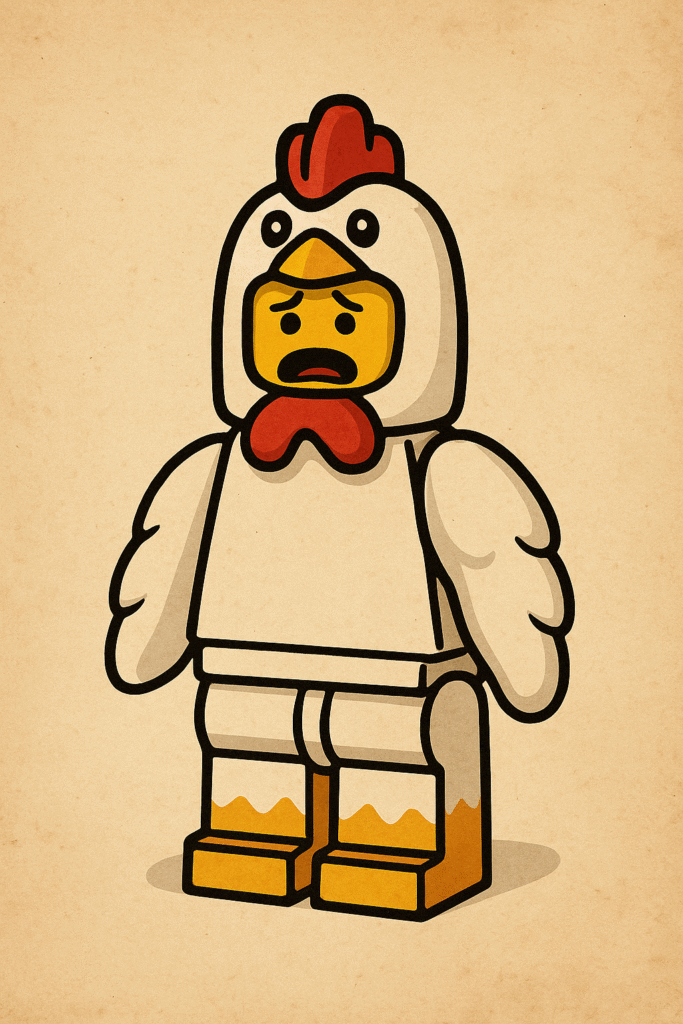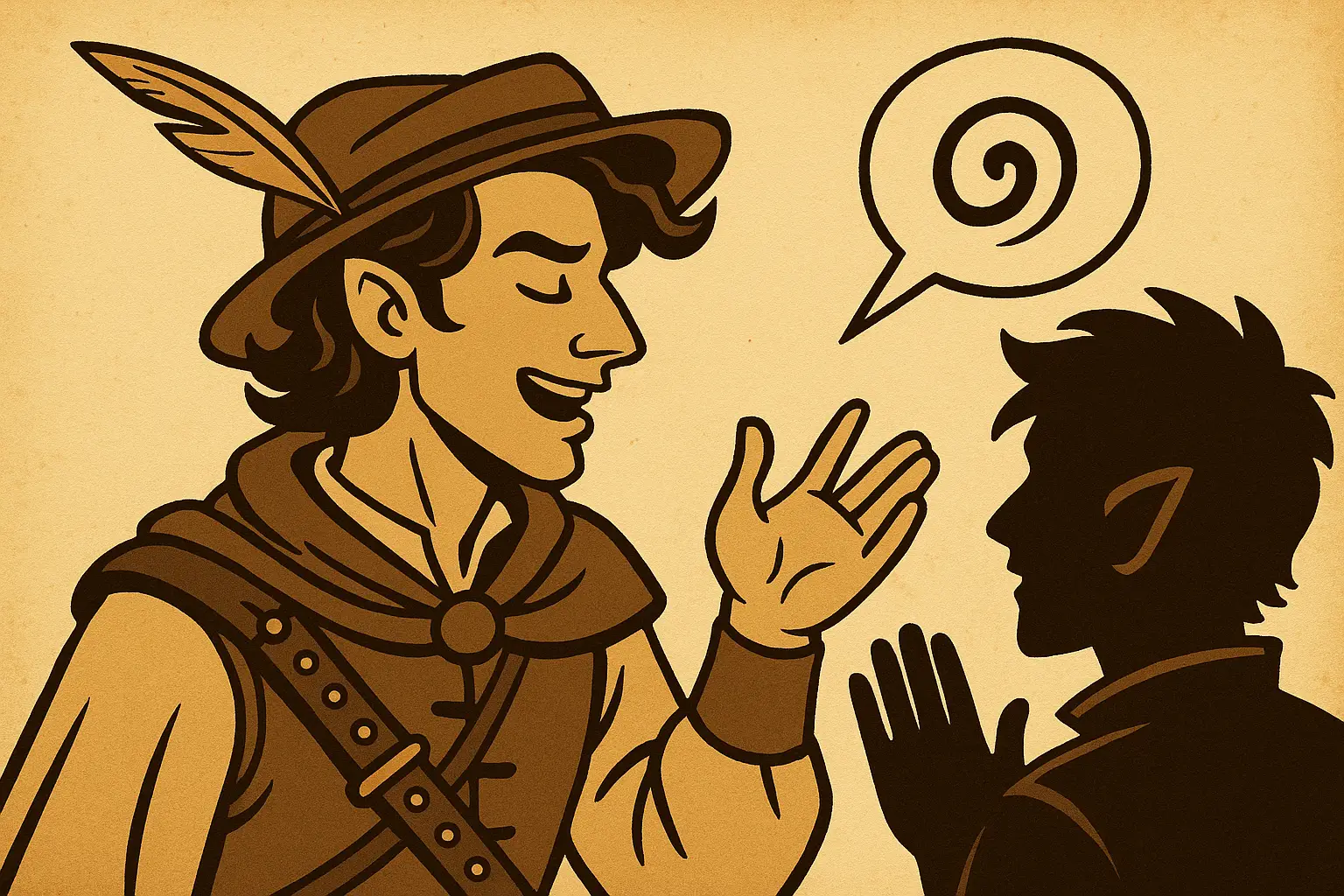How fear-based characters add humor, drama, and surprise heroism to your next campaign
Bravery is overrated.
Sure, it’s cool when the paladin charges the dragon or the barbarian holds the bridge with 2 HP and a broken axe. But you know what your campaign really needs?
A coward.
The one who says, “Nope,” when danger looms. The one who hides behind barrels, fakes death at the first sign of danger, and questions everything the party tries to do.
Why?
Because in a world of heroes and monsters, the coward is what makes the story great.
We’re here to make the case for the fear-driven character archetype—the sniveling, scheming, surprisingly resourceful companion that brings the laughs, the tension, and sometimes, the most unforgettable moments in your game.
For a perfect visual inspiration of this kind of character archetype in miniature, check out the LEGO Chicken Suit Guy keychain—it’s equal parts silly and symbolic. View it here
Let’s dig into the glory of fear.

🧠 What Is a “Cowardly” Character, Really?
We’re not talking about annoying, non-cooperative characters who derail games or refuse to engage.
A cowardly character, done well, is:
- Narratively engaged (they just panic about it)
- Fear-driven, not useless (they want to help… from behind cover)
- Emotionally rich (their fear often hides a more complex motivation)
- Capable of growth (or not—that’s fine too)
Think of classic examples like:
- Rincewind (Discworld) – The wizard who always runs, but somehow always survives.
- C-3PO (Star Wars) – Complains constantly, but always shows up.
- Luigi (Luigi’s Mansion) – Terrified, yet goes into the haunted house anyway.
- Samwell Tarly (Game of Thrones) – Afraid of everything… but kills a White Walker.
Cowardly characters aren’t cowards for no reason. They reflect the human side of adventuring—fear, anxiety, survival instinct.
And they make for excellent party dynamics.
🎭 Why the Coward Archetype Works
1. They Make Everyone Else Feel Brave
You don’t notice how fearless your fighter is… until your rogue refuses to go through the creepy door.
Fear is a spotlight. It enhances courage by contrast.
- The coward shrinks from danger → the bard’s speech feels more heroic.
- The coward flees the battle → the druid’s stand means more.
It’s character alchemy.
2. They Create Great Party Banter
Fear = jokes. And jokes = bonding.
Every table needs a:
“Are you sure it’s dead?”
“You guys go ahead—I’ll watch the horses.”
“I’ll come in… right after you say it’s safe.”
Cowardly characters provide levity without breaking tone. Their sarcasm, reluctance, and survival instincts make even tense scenes memorable.
And when done well, they become the most quotable characters at the table.
3. They Can Still Be Useful
Cowards aren’t helpless. In fact, their fear often makes them:
- Strategic (they don’t rush into danger)
- Creative (they find ways to avoid fights)
- Fast thinkers (they panic-productively)
A cowardly wizard might be the first to spot an ambush. A rogue who’s terrified of traps will actually check for them.
The best cowardly characters find ways to help because they’re scared.
4. They Set Up Amazing Character Arcs
What happens when the coward saves the day?
When they come back to pull someone from the fire?
When they draw a sword, hands shaking, because it’s the right thing to do?
You get the biggest moments in the campaign.
Because everyone expects bravery from the fighter. But when the scared little thief steps forward? Everyone pays attention.
Cowards turn into surprise heroes—and that growth feels earned, not given.
🐔 The Chicken Suit Metaphor: Cowardice in Style
There’s something inherently iconic about a character who’s dressed for silliness but still shows up. The LEGO Chicken Suit Guy is a perfect visual metaphor.
- Silly? Yes.
- Timid? Probably.
- Forgettable? Never.
They don’t wear armor. They wear a mascot costume. They don’t charge into battle—they panic, scream, and somehow live to panic again.
And yet… you love them for it.
Sometimes your campaign needs less grimdark. Sometimes it needs someone who doesn’t want to be there, but is anyway.
Because that’s how you get real courage.
🎲 How to Play a Cowardly Character Well
If you want to be the party’s lovable, panic-prone disaster—great. Here’s how to do it without being That Guy™:
✅ Do:
- Be afraid, but still act
- Make decisions based on logic (even if it’s self-preserving logic)
- Use your fear to highlight danger
- Step up sometimes—fear doesn’t mean never engaging
- Use your cowardice for roleplay, not rule-breaking
❌ Don’t:
- Constantly run away without consequences
- Refuse to participate in key moments
- Sabotage the group
- Use cowardice to justify selfishness every time
Think “reluctant hero” or “survivalist comic relief,” not “spoiled brat.”
🧱 LEGO Tabletop Bonus: Minifigs with Personality
If you’re using LEGO for your TTRPG sessions or battle builds (and why wouldn’t you?), a cowardly character adds fantastic visual storytelling to your setup.
Picture this:
- A battlefield scene with knights clashing, dragons roaring… and one figure in a chicken suit peeking from behind a bush.
- A siege where everyone’s firing from the ramparts… except for the guy who dropped his sword and is crawling away.
- A dungeon party all posing for glory… and one minifig turned completely the wrong direction.
These moments make your LEGO scenes memorable and funny—and reflect the same spirit of character as your campaign.
📜 Sample Cowardly Character Concepts
Need inspiration? Here are five fear-based archetypes you can build:
🐀 The Ratty Rogue
- Skittish, greedy, always scouting exits.
- “I’m not running. I’m retreating strategically.”
- Often the first to spot danger—and the first to abandon you.
📚 The Cowardly Wizard
- Reads every spell like it might bite.
- Fumbles scrolls. Trips on robes.
- Somehow survives every fireball.
🕊 The Pacifist Cleric
- Deeply believes in peace, even when surrounded by murderhobos.
- Terrified of violence—but casts healing in a panic better than anyone else.
🪤 The Bard Who Talks Too Much
- Uses comedy to hide fear.
- Hides behind charisma rolls.
- Is devastated when things actually get serious.
🧺 The Reluctant Chosen One
- Prophecied for greatness. Hates it.
- Constantly looking for a way out.
- Will break your heart when they finally do something brave.
🎉 The Payoff: When the Coward Wins
Let’s say your cowardly character survives the campaign. They faced their fear. Maybe they still panic at loud noises, but they stuck around.
What’s left?
Legend.
Because those stories—the time they bluffed a demon while crying, or rolled a nat 20 to jump off a collapsing bridge into the arms of the barbarian—those are the moments that stick with your table forever.
Courage is great.
But reluctant courage?
That’s unforgettable.
🐣 Final Thoughts: Long Live the Chicken-Hearted
Not every party member needs to be a badass.
Not every moment needs to be solemn.
Sometimes, the best tension, the best humor, and the most surprising drama come from the scared little guy in the chicken suit who refuses to die.
So next time you roll a character?
Skip the grim avenger. Forget the chosen one.
Try being the coward.
You might just be the bravest one of all.
